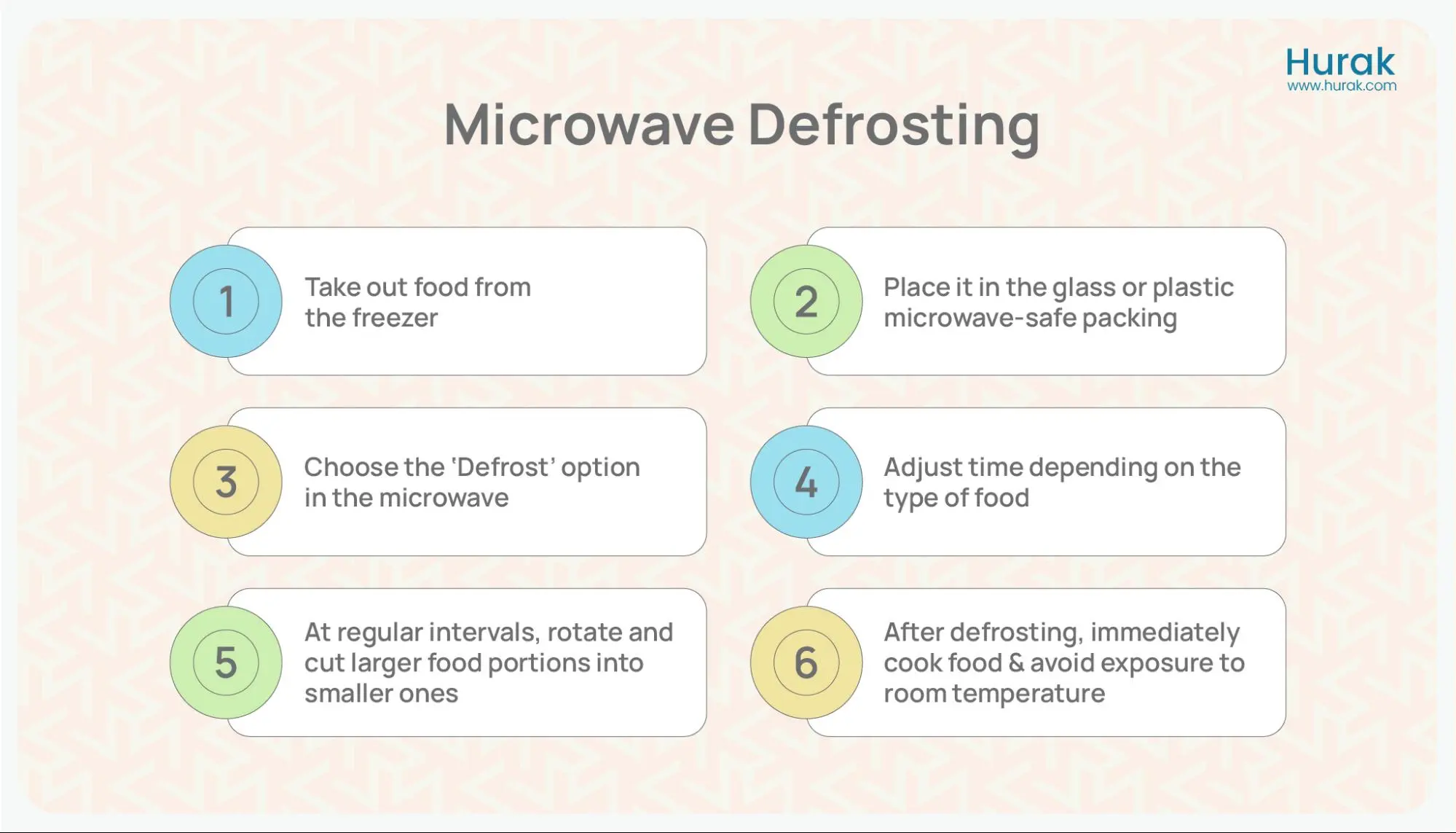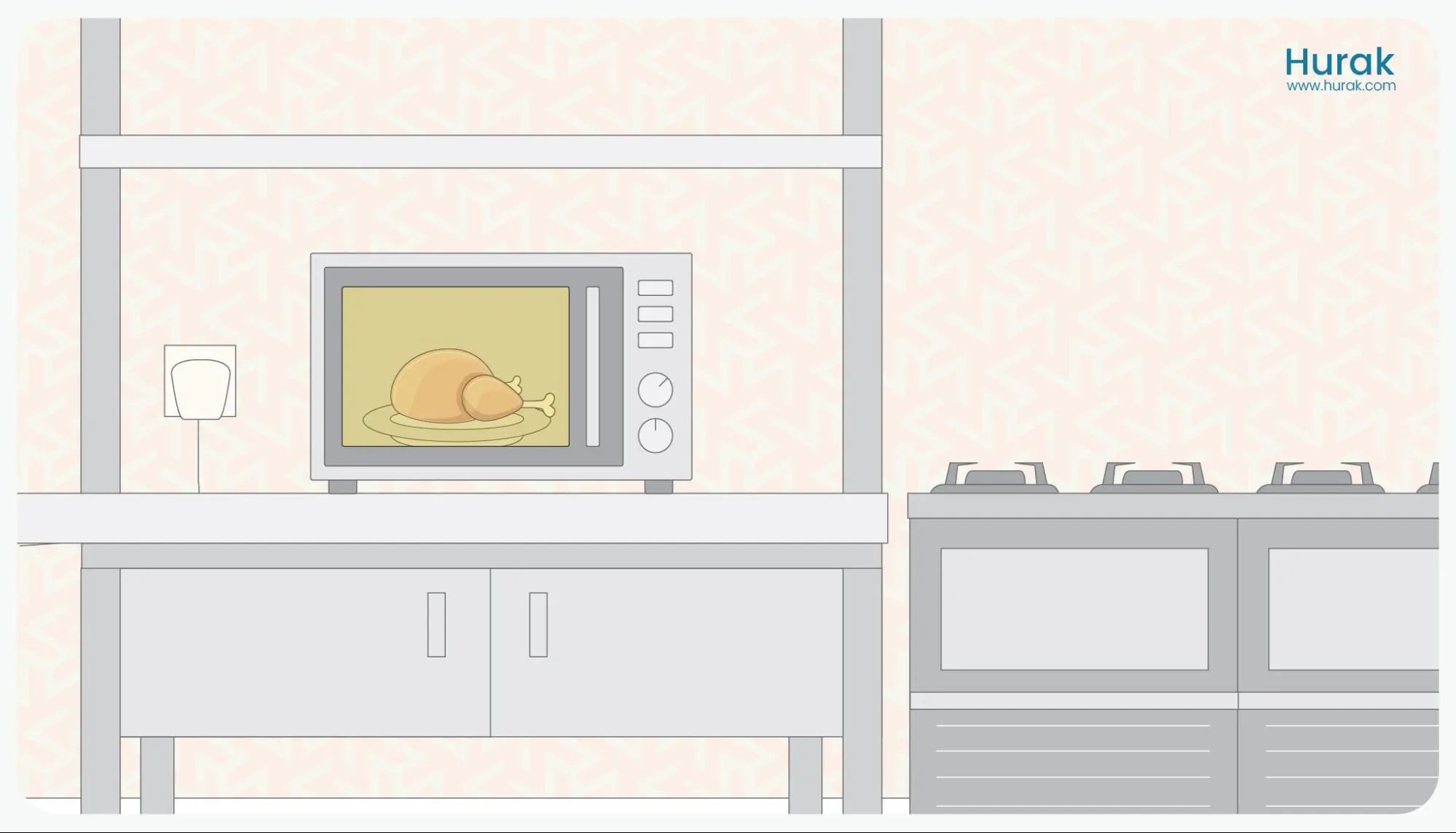Microwaves are the most commonly used kitchen devices for warming up food. For proper defrosting, food is kept in a microwave safe-glass container. The appliance is then set to defrosting mode. Microwave defrosting saves time and provides convenience, however, defrosting food in the refrigerator is a safer option.
Food is kept frozen at -18°C. Freezing preserves food by slowing down microbial activity. During freezing, water in food is formed into ice crystals. Less water content is available for bacteria to thrive. Some foods can be cooked directly from frozen, while most are defrosted before cooking.
How Does Food Defrost in the Microwave?
Defrosting is the process of removing ice or frost from frozen items. Microwave is an appropriate food reheating and defrosting machine for domestic and commercial kitchens. It uses electromagnetic waves to increase the kinetic energy of water molecules in food. Water molecules vibrate and generate heat, warming up the whole food. It is quick and convenient. While defrosting frozen food in a refrigerator takes hours or days, the microwave takes a few minutes to defrost food taken out of the freezer.
Is it Safe to Defrost Food in the Microwave?
Ideally, do not defrost food in a microwave. It carries the risk of exposing food to the temperature ‘Danger Zone’. The bacteria that were inactive in the frozen state grow twice as fast at the danger zone temperature. This is why it is important to cook food at high temperatures immediately after microwave defrosting, to destroy harmful bacteria.
Get Online Food Safety Courses
Food Hygiene And Safety
Check the CourseRated Excellent
on major review sites

How to Defrost Food in the Microwave?
There are six easy steps to carry out defrosting in the microwave safely. Food is kept in the microwave-safe container made up of glass or plastic. Plain paper plates and microwave-safe zipper bags are also used for defrosting food.
Step 1: Take out Food from the Freezer
Proper freezing of food takes place at -18°C (0° F). Frozen food is taken out of the freezer and is prepared for microwave defrosting.
Step 2: Use Appropriate Packaging for Microwave Defrosting
Transfer the food to a microwave-safe container. They can be made of plastic or glass. Glass containers are the best choice.
Step 3: Set the Defrost Option on the Microwave
Usually, microwaves have a defrost option. If not, adjust according to the setting’s instructions of the microwave. Use the level button to set the power to 20-30 per cent. Other microwaves require mass measurements of food to automatically calculate the defrosting time.
Step 4: Adjust Microwave Timer for Defrosting
Typically, raw frozen poultry or beef take 7-10 minutes for thorough defrosting. Vegetables take 2-3 minutes. Adjust time accordingly for different food types mentioned on the package label.
Step 5: Cut Food into Smaller Pieces
At regular intervals, make sure that all sides of food are exposed to heat. Cut larger pieces of food into smaller ones. This is done to increase and expose a larger surface area of food to heat for thorough and rapid heating.
Step 6: Immediately Cook Defrosted Food
Once the food is defrosted, immediately cook it. Do not leave defrosted food at room temperature for a prolonged time. This reduces the probability of microbial contamination of food.

How Long Does it Take For Microwave Defrosting
Unlike other microwave functions that run at 100% power, the defrost setting reduces power levels to 20%–30%. Defrosting times are also based on weight.

Which Foods Can be Defrosted in the Microwave
It is always preferred to use the refrigerator for defrosting food. If a quicker and easier method is required, then a microwave can be used in such circumstances. However, caution should be practised because not all food types can be defrosted in a microwave.

Defrosting Raw Frozen Chicken in the Microwave
Raw frozen chicken can be defrosted in a microwave directly by placing it in a microwave-safe container. Adjust the settings and timer of the microwave for defrosting. For every pound of chicken, 8-10 minutes are required for defrosting. Once the chicken has been defrosted, cook it immediately.
Whole chicken is not recommended to be defrosted in a microwave. Uneven heating is a common cause where some portions of meat get defrosted faster than others, leading to microbial growth. Microwave defrosting should be done for smaller chicken pieces.

Which Containers are Microwave-Safe?
You can safely place containers in the microwave made up of the following materials:
- glass
- silicone ceramics
Which Containers Are Not Microwave-Safe?
Make sure not to place the following containers in the microwave as they may cause electric sparking or food contamination.
- Crystal
- handcrafted pottery
- plastics
- Styrofoam
- cardboard
- metals such as steel, iron, copper or other heavy metals
- wrinkled aluminium foil

Fridge Defrosting versus Microwave Defrosting
Refrigeration safely defrosts food at below 5°C, at which bacteria remains inactivated. If the frozen food is left out at room temperature for over 20 minutes, avoid defrosting it in the microwave. Instead, thaw it in ice-cold water or a fridge.

FAQs
Can you freeze defrosted chicken more than once?
If defrosting takes place in the fridge, refreezing is possible within two days. Raw chicken defrosted in the microwave should be refrozen after it is fully cooked.
Is it safe to defrost food in the microwave?
Defrosting food in the microwave is safe if it is kept for an appropriate time duration at the defrost setting. However, defrosting food in the fridge is a safer option.
How long does it take to defrost meat in the microwave?
Each pound of meat takes 8-12 minutes to defrost in the microwave. Time duration for microwave defrosting
Which containers are microwave-safe for defrosting food?
Containers made of glass or silicone ceramic are safe materials for defrosting food in the microwave.
Conclusion
Microwave defrosting is a convenient but less safe method compared to refrigerator defrosting. While it saves time, it increases the risk of bacterial growth due to exposure to the temperature danger zone. However, if opting for microwave defrosting, follow safety measures such as using appropriate containers and cooking immediately after defrosting to minimise microbial contamination.




